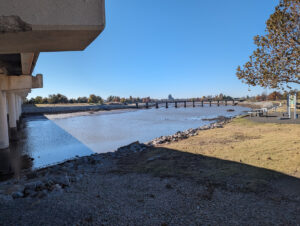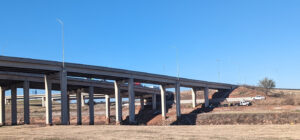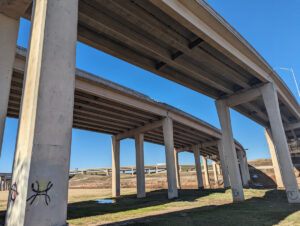 Our local news channels noted roughly a year ago that, as part of the most recent edition of the MAPS Project (gussying up OKC for tourism), there was a plan to build a pedestrian bridge across the river near the new OKANA recreation facilities being built on the grounds of the First Americans Museum. In order to start that bridge, the water level would have to be dropped so workers could install the necessary supports. Thus, in our first image, one gate is down all the way, allowing water to flow out that section of the river.
Our local news channels noted roughly a year ago that, as part of the most recent edition of the MAPS Project (gussying up OKC for tourism), there was a plan to build a pedestrian bridge across the river near the new OKANA recreation facilities being built on the grounds of the First Americans Museum. In order to start that bridge, the water level would have to be dropped so workers could install the necessary supports. Thus, in our first image, one gate is down all the way, allowing water to flow out that section of the river.
 In this view, we see the resulting low water level in the competition rowing section of the Oklahoma River Recreation Area. The Chesapeake Boathouse removed all the floating docks to keep them from coming to rest in the muddy river bottom. It takes a while for all the water to drain off because there are numerous drainage sources from the Downtown OKC area feeding into this section of the river. Every time it rains, they dump a lot more water into the river.
In this view, we see the resulting low water level in the competition rowing section of the Oklahoma River Recreation Area. The Chesapeake Boathouse removed all the floating docks to keep them from coming to rest in the muddy river bottom. It takes a while for all the water to drain off because there are numerous drainage sources from the Downtown OKC area feeding into this section of the river. Every time it rains, they dump a lot more water into the river.
 Now there is yet another delay. This past Sunday, during the overnight ours leading to Sunday morning, we had a lot of rain, followed by freezing temperatures. The infamous Fort Smith Junction here in OKC froze over, and there was a massive pile-up of 22 vehicles. A tractor-trailer rig approached and tried to dodge the mass of wreckage and managed to roll over the retaining wall, falling into the river below. The trailer came apart and dumped its cargo into the water. There were crews working to collect evidence and another crew cleaning up the mess.
Now there is yet another delay. This past Sunday, during the overnight ours leading to Sunday morning, we had a lot of rain, followed by freezing temperatures. The infamous Fort Smith Junction here in OKC froze over, and there was a massive pile-up of 22 vehicles. A tractor-trailer rig approached and tried to dodge the mass of wreckage and managed to roll over the retaining wall, falling into the river below. The trailer came apart and dumped its cargo into the water. There were crews working to collect evidence and another crew cleaning up the mess.
 Here in the dead center of the photo is the guardrail damage from the truck striking it hard before climbing up and over it. Apparently the cargo is being treated as toxic, because there are temporary dams across the river to prevent it all floating downstream. This is all just a quarter-mile downstream from that dam that had been open, but is now closed again. The city stopped the water flow until the crews could clear the crash scene. They were using a special heavy wrecker on the bridge above with a long, rotating crane boom to lift a collection container being filled by workers down in the shallow water below.
Here in the dead center of the photo is the guardrail damage from the truck striking it hard before climbing up and over it. Apparently the cargo is being treated as toxic, because there are temporary dams across the river to prevent it all floating downstream. This is all just a quarter-mile downstream from that dam that had been open, but is now closed again. The city stopped the water flow until the crews could clear the crash scene. They were using a special heavy wrecker on the bridge above with a long, rotating crane boom to lift a collection container being filled by workers down in the shallow water below.

